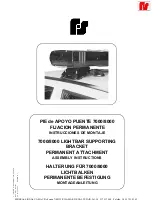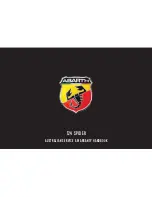
07 Wheels and tires
Glossary of tire terminology
07
183
Terminology
•
Tire information placard
: A placard
showing the OE (Original Equipment) tire
sizes, recommended inflation pressure,
and the maximum weight the vehicle can
carry.
•
Tire Identification Number (TIN)
: A num-
ber on the sidewall of each tire providing
information about the tire brand and man-
ufacturing plant, tire size and date of man-
ufacturer.
•
Inflation pressure
: A measure of the
amount of air in a tire.
•
Standard load
: A class of P-metric or Met-
ric tires designed to carry a maximum load
at 35 psi [37 psi (2.5 bar) for Metric tires].
Increasing the inflation pressure beyond
this pressure will not increase the tires load
carrying capability.
•
Extra load
: A class of P-metric or Metric
tires designed to carry a heavier maximum
load at 41 psi [43 psi (2.9 bar) for Metric
tires]. Increasing the inflation pressure
beyond this pressure will not increase the
tires load carrying capability.
•
kPa
: Kilopascal, a metric unit of air pres-
sure.
•
PSI
: Pounds per square inch, a standard
unit of air pressure.
•
B-pillar
: The structural member at the side
of the vehicle behind the front door.
•
Bead area of the tire
: Area of the tire next
to the rim.
•
Sidewall of the tire
: Area between the
bead area and the tread.
•
Tread area of the tire
: Area of the perim-
eter of the tire that contacts the road when
mounted on the vehicle.
•
Rim
: The metal support (wheel) for a tire or
a tire and tube assembly upon which the
tire beads are seated.
•
Maximum load rating
: a figure indicating
the maximum load in pounds and kilo-
grams that can be carried by the tire. This
rating is established by the tire manufac-
turer.
•
Maximum permissible inflation pres-
sure
: the greatest amount of air pressure
that should ever be put in the tire. This limit
is set by the tire manufacturer.
•
Recommended tire inflation pressure
:
inflation pressure, established by Volvo,
which is based on the type of tires that are
mounted on a vehicle at the factory. This
information can be found on the tire infla-
tion placard(s) located on the driver's side
B-pillar and in the tire inflation table in this
chapter.
•
Cold tires
: The tires are considered to be
cold when they have the same temperature
as the surrounding (ambient) air. This tem-
perature is normally reached after the car
has been parked for at least 3 hours.
Properly loading your vehicle will provide maxi-
mum return of vehicle design performance.
Summary of Contents for S40 2011
Page 1: ...VOLVO V50 Owner s Manual Web Edition ...
Page 2: ......
Page 8: ...Contents 8 12 12 Index Index 282 ...
Page 9: ...Contents 9 ...
Page 17: ...SAFETY ...
Page 51: ...INSTRUMENTS AND CONTROLS ...
Page 52: ...02 Instruments and controls Instrument overview 02 52 G019488 ...
Page 91: ...CLIMATE ...
Page 103: ...INTERIOR ...
Page 111: ...04 Interior Storage compartments 04 111 ...
Page 121: ...LOCKS AND ALARM ...
Page 137: ...STARTING AND DRIVING ...
Page 171: ...06 Starting and driving 06 171 ...
Page 173: ...WHEELS AND TIRES ...
Page 202: ...202 Washing and cleaning the car 204 Paint touch up 208 ...
Page 203: ...CAR CARE ...
Page 209: ...08 Car care 08 209 ...
Page 211: ...MAINTENANCE AND SERVICING ...
Page 239: ...AUDIO ...
Page 263: ...10 Audio 10 263 ...
Page 265: ...SPECIFICATIONS ...
Page 266: ...11 Specifications Label information 11 266 ...
Page 281: ...11 Specifications 11 281 ...
Page 290: ...12 Index 12 290 ...
Page 291: ......
Page 292: ...Kdakd 8Vg 8dgedgVi dc IE JH6 8VcVYV 6I Eg ciZY c HlZYZc iZWdg 8deng i Kdakd 8Vg 8dgedgVi dc ...
















































